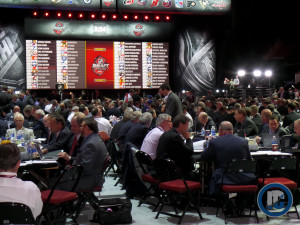
If you missed yesterday’s piece, the main assertion was that skill and hockey sense carry the day at the NHL Entry Draft. Once in a blue moon you find the perfect prospect – Mario Lemieux – who has an awe-provoking blend of size, skating, skill, and hockey sense. But in virtually every other case, each prospect has at least a wart or two – for instance, some scouts were concerned that John Tavares’ skating was going to limit his NHL upside, while others thought Patrick Kane was too slight to handle the physical nature of the NHL!
So the question is, if as a scout/GM, you have to pick and choose which traits you are looking for most, which would you place the most value upon? Let’s look at a few teams whose drafting philosophies have been in stark contrast to one another:
New Jersey Devils’ Draft History
The New Jersey Devils have had tremendous success in the past 20 years. They won the Stanley Cup in 1995, 2000, and 2003, and made a finals appearance in 2012. However, in the past 10 years, it’s likely that no team has had less success at the NHL Draft. (As a result, the Devils have entered the dark ages – even with the incredible Corey Schneider, this team may struggle to make playoffs for the next several years)
From 2005 – 2014, it’s not a stretch to say that the Devils have drafted just one high-quality, top-6 NHL forward – Adam Henrique – out of the 37 forwards they’ve selected. (Though there’s still some hope for Reid Boucher and John Quenneville). Meanwhile, out of 25 defencemen, they have two so far that could be considered top-4 quality defencemen (at least potentially), in Adam Larsson, and Damon Severson. What happened to all the rest?
It should be acknowledged that the Devils’ success left them picking lower in the draft for many years, so the scouting department had very few gimmes (apart from perhaps Adam Larsson – 4th overall in 2011). But that said, when you see picks like these, it’s no wonder that they find themselves in their current position:
New Jersey Pick Other Possible Pick
Niklas Bergfors – 23rd in 2005 T.J Oshie, 24th
Mattias Tedenby – 24th in 2008 Tyler Ennis – 26th
Jacob Josefson – 20th in 2009 Kyle Palmieri – 26th
Stefan Matteau – 29th in 2012 Tanner Pearson, 30th
Steve Santini – 42nd in 2013 Madison Bowey, 53rd
Now in some cases, you might just say these are unfortunate coincidences. Bergfors-Oshie probably qualifies there, for instance. But when you look at things in more detail, you start to see patterns emerge. Some of the early misses – Tedenby, Josefson, Jon Merrill – their first picks in 2008, 2009, and 2010 – are all tremendous skaters – among the best available in those drafts years. Is it a coincidence that they all ended up drafted by the Devils? Or were the Devils valuing skating above other factors, like say, skill? Tyler Ennis – a Josefson alternative – is himself is a good skater, but he was also producing big-time offensive results in the WHL in his draft year – 91 points in 70 games, on a Medicine Hat Tigers squad where no one else had more than 70 points. Kyle Palmieri – who is used as a comparable for Josefson specifically because the Devils acquired him last off-season – was seen as a tremendous goal scorer on draft day, but one who didn’t necessarily have the physical tools to dominate at the next level. Interestingly, once Kyle finally got some playing time in New Jersey, he managed to score 30 goals this season. Josefson, meanwhile, has 17 goals in 238 NHL games.
So while a focus on skating may help explain a few draft misses, there was another, bigger phase of Devils’ draft mismanagement:
2006 Matt Corrente, 30th; Kirill Tulopov, 67th
2008 – Patrice Cormier – 54th
2007 – Mike Hoeffel, 57th; Nick Palmieri, 79th
2009 – Eric Gelinas, 54th; Alexander Urbom – 73rd
2012 – Stefan Matteau, 29th
2013 – Steve Santini, 42nd
While the Devils did make a few good picks in this time span, all of the players listed above have something in common: their primary traits on draft day involved size, aggressiveness, and “defensive ability”, as opposed to skill. Matt Corrente was a semi-skilled defensive prospect who racked up 172 PIMs in the OHL in his draft year; Mike Hoeffel and Nick Palmieri were both over 6’3, 205 lbs, and showed only flashes of skill, never producing big offence before or after being drafted. Patrice Cormier was an aggressive player, lauded for his “two-way” game, which hasn’t really translated to either end of the rink in pro hockey; meanwhile, Alexander Urbom, Eric Gelinas, and Kirill Tulupov are all between 6’3 and 6’5, and of the trio, only Gelinas might emerge as a bottom-pair NHL defenceman. (He was traded to Colorado this year for a 3rd round pick). More recently, the Devils have picked forward Stefan Matteau – son of former Ranger, Stephane Matteau – 6’2, 220, with almost no offensive ability – and defender Steve Santini – heralded as a “rock-solid” defensive defenceman, with little or no offensive upside.
37 forwards and 25 defencemen, and the Devils end up with Henrique, Larsson, Severson, a few question marks, and a lot of disappointment.
Detroit Red Wings’ Draft History
Everyone knows the story of the Detroit Red Wings. Steve Yzerman is drafted 4th overall in 1983, he becomes the captain in 1986 – at age 21 – they steadily improve under his leadership, manage to draft incredible Europeans like Lidstrom, Fedorov, Konstantinov, and others in the late rounds, they suffer a few playoff setbacks before Scotty Bowman is hired in 1993, he takes them to a new level, and they end up winning several Stanley Cups – 1997, 1998, 2002, and 2008.
Overall, this side of the argument is simpler to make. It goes something like this:
The Red Wings value skill and hockey sense above all else. Size is great, but not in the absence of skill. Regardless of positional need, country of origin, size, or sometimes, even skating ability, we will look for skill and sense first, and everything else second.
Everyone knows about the draft-day thefts of Pavel Datysuk (6th round, 1998), and Henrik Zetterberg (8th round, 1999), but the fruits of good scouting have continued, now over 15 years later. Here are the more recent products of that mentality:
2000 – Niklas Kronwall, 29th
2001 – Igor Grigorenko, 62nd – big things were expected by the organization after he scored 19 goals as a teenager in the Russian super league, but a severe car accident in 2003 derailed his career
2002 – Jiri Hudler (58th), Tomas Fleischmann (63rd), Valtteri Filppula (95th)
2005 – Darren Helm, 132nd
2008 – Gustav Nyquist, 121st
2009 – Tomas Tatar, 60th
2010 – Calle Jarnkrok (51st), Teemu Pulkkinen (111th)
2012 – Andreas Athanasiou, 110th
2013 – Anthony Mantha, 20th
2014 – Dylan Larkin, 15th
2015 – Evgeni Svechnikov (19th), Vili Saarajarvi (73rd)
*Note: There were a few lean years from 2003-2007 where the Wings didn’t have a first round pick at all 2003, 2004, 2006), and they also took a few big bodies like Johan Franzen, Justin Abdelaker, and Brendan Smith, who did work out, but who aren’t necessarily consistent with their primary strategy
All of the players listed above were drafted based on their skill and sense, regardless of, and often in spite of their size. Since the Wings haven’t finished quite as high in the standings in recent years, it’s given them a chance to draft a bit higher, and get a player with both size and skill – Mantha, Larkin, and Svechnikov are all examples of that. However, since the Wings were so good for so long, and often were loading up for playoff runs (and giving up high picks), just about every other player on this list is a non-first rounder, meaning they usually had to make a choice between size and skill. With the exceptions of Fleischmann and Athanasiou, and the aforementioned Mantha, Larkin, and Svechnikov, every other player in this list is under 6′! (Though Valtteri Filppula is exactly 6′).
What about the Jets?
There’s good news: The Winnipeg Jets fully understand and appreciate that skill is king and hockey sense. Drafting Scheifele over Couturier, the impressive, Ehlers over a power forward (some were concerned Cheveldayoff might want Nick Ritchie), undersized players like Nic Petan, Chase De Leo, Michael Spacek, and Josh Morrissey over strapping Manitoba boy, Ryan Pulock (while not necessarily a good choice in retrospect, it does highlight the strategy), are all great examples of this approach.
As a result, the Jets are the envy of much of the league, despite not drafting higher than 7th overall prior to the 2016 draft. How many teams have a better group of under-25 players than the Jets:
| # | U-25 | Pos | YOB | Age |
| 1 | Scheifele | C | 1993 | 23 |
| 2 | Ehlers | W | 1996 | 20 |
| 3 | Connor | W | 1996 | 20 |
| 4 | Petan | C | 1995 | 21 |
| 5 | Lemieux | W | 1996 | 20 |
| 6 | Armia | W | 1993 | 23 |
| 7 | Dano | W | 1994 | 22 |
| 8 | Roslovic | C | 1997 | 19 |
| 9 | Copp | C | 1994 | 22 |
| 10 | Lowry | C | 1993 | 23 |
| 11 | Kosmachuk | W | 1994 | 22 |
| 12 | De Leo | W | 1995 | 21 |
| 13 | Harkins | C | 1997 | 19 |
| 14 | Foley | W | 1997 | 19 |
| 15 | Spacek | C | 1997 | 19 |
| 1 | Trouba | RD | 1994 | 22 |
| 2 | Morrissey | LD | 1995 | 21 |
| 3 | Poolman | RD | 1993 | 23 |
| 1 | Hellebuyck | G | 1993 | 23 |
| 2 | Comrie | G | 1995 | 21 |
While that isn’t necessarily an roster in itself, there are a number of impact players on there – and that’s before picks #2, 22, and 36 get added on in this year’s draft – and there is a ton of depth there as well with the Copp’s, Lowry’s, Lemieux’s, and others.
The Jets are much closer to the Wings than they are to the Devils, and for that, fans can thank Marcel Comeau, Mark Hillier, and the rest of the Amateur Scouting Department. And perhaps Kevin Cheveldayoff, too.


